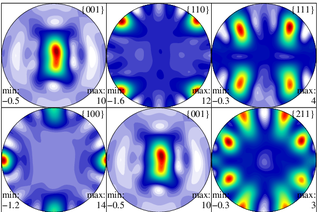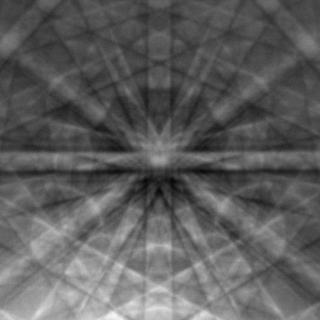Related Research Articles

Mineralogy is a subject of geology specializing in the scientific study of the chemistry, crystal structure, and physical properties of minerals and mineralized artifacts. Specific studies within mineralogy include the processes of mineral origin and formation, classification of minerals, their geographical distribution, as well as their utilization.

Metamorphic rocks arise from the transformation of existing rock to new types of rock in a process called metamorphism. The original rock (protolith) is subjected to temperatures greater than 150 to 200 °C and, often, elevated pressure of 100 megapascals (1,000 bar) or more, causing profound physical or chemical changes. During this process, the rock remains mostly in the solid state, but gradually recrystallizes to a new texture or mineral composition. The protolith may be an igneous, sedimentary, or existing metamorphic rock.

Metamorphism is the transformation of existing rock to rock with a different mineral composition or texture. Metamorphism takes place at temperatures in excess of 150 °C (300 °F), and often also at elevated pressure or in the presence of chemically active fluids, but the rock remains mostly solid during the transformation. Metamorphism is distinct from weathering or diagenesis, which are changes that take place at or just beneath Earth's surface.

Amphibolite is a metamorphic rock that contains amphibole, especially hornblende and actinolite, as well as plagioclase feldspar, but with little or no quartz. It is typically dark-colored and dense, with a weakly foliated or schistose (flaky) structure. The small flakes of black and white in the rock often give it a salt-and-pepper appearance.

Anorthosite is a phaneritic, intrusive igneous rock characterized by its composition: mostly plagioclase feldspar (90–100%), with a minimal mafic component (0–10%). Pyroxene, ilmenite, magnetite, and olivine are the mafic minerals most commonly present.

In physical chemistry and materials science, texture is the distribution of crystallographic orientations of a polycrystalline sample. A sample in which these orientations are fully random is said to have no distinct texture. If the crystallographic orientations are not random, but have some preferred orientation, then the sample has a weak, moderate or strong texture. The degree is dependent on the percentage of crystals having the preferred orientation.

Electron backscatter diffraction (EBSD) is a scanning electron microscopy (SEM) technique used to study the crystallographic structure of materials. EBSD is carried out in a scanning electron microscope equipped with an EBSD detector comprising at least a phosphorescent screen, a compact lens and a low-light camera. In this configuration, the SEM incident beam hits the tilted sample. As backscattered electrons leave the sample, they interact with the crystal's periodic atomic lattice planes and diffract according to Bragg's law at various scattering angles before reaching the phosphor screen forming Kikuchi patterns (EBSPs). EBSD spatial resolution depends on many factors, including the nature of the material under study and the sample preparation. Thus, EBSPs can be indexed to provide information about the material's grain structure, grain orientation, and phase at the micro-scale. EBSD is applied for impurities and defect studies, plastic deformation, and statistical analysis for average misorientation, grain size, and crystallographic texture. EBSD can also be combined with energy-dispersive X-ray spectroscopy (EDS), cathodoluminescence (CL), and wavelength-dispersive X-ray spectroscopy (WDS) for advanced phase identification and materials discovery.
A pole figure is a graphical representation of the orientation of objects in space. For example, pole figures in the form of stereographic projections are used to represent the orientation distribution of crystallographic lattice planes in crystallography and texture analysis in materials science.

Mylonite is a fine-grained, compact metamorphic rock produced by dynamic recrystallization of the constituent minerals resulting in a reduction of the grain size of the rock. Mylonites can have many different mineralogical compositions; it is a classification based on the textural appearance of the rock.

Cumulate rocks are igneous rocks formed by the accumulation of crystals from a magma either by settling or floating. Cumulate rocks are named according to their texture; cumulate texture is diagnostic of the conditions of formation of this group of igneous rocks. Cumulates can be deposited on top of other older cumulates of different composition and colour, typically giving the cumulate rock a layered or banded appearance.

In geology, texture or rock microstructure refers to the relationship between the materials of which a rock is composed. The broadest textural classes are crystalline, fragmental, aphanitic, and glassy. The geometric aspects and relations amongst the component particles or crystals are referred to as the crystallographic texture or preferred orientation. Textures can be quantified in many ways. The most common parameter is the crystal size distribution. This creates the physical appearance or character of a rock, such as grain size, shape, arrangement, and other properties, at both the visible and microscopic scale.
In metallurgy, materials science and structural geology, subgrain rotation recrystallization is recognized as an important mechanism for dynamic recrystallisation. It involves the rotation of initially low-angle sub-grain boundaries until the mismatch between the crystal lattices across the boundary is sufficient for them to be regarded as grain boundaries. This mechanism has been recognized in many minerals and in metals.
Akimotoite is a rare silicate mineral in the ilmenite group of minerals, with the chemical formula (Mg,Fe)SiO3. It is polymorphous with pyroxene and with bridgmanite, a natural silicate perovskite that is the most abundant mineral in Earth's silicate mantle. Akimotoite has a vitreous luster, is colorless, and has a white or colorless streak. It crystallizes in the trigonal crystal system in space group R3. It is the silicon analogue of geikielite (MgTiO3).

Tobermorite is a calcium silicate hydrate mineral with chemical formula: Ca5Si6O16(OH)2·4H2O or Ca5Si6(O,OH)18·5H2O.
Silicate perovskite is either (Mg,Fe)SiO3 or CaSiO3 when arranged in a perovskite structure. Silicate perovskites are not stable at Earth's surface, and mainly exist in the lower part of Earth's mantle, between about 670 and 2,700 km depth. They are thought to form the main mineral phases, together with ferropericlase.
Paleostress inversion refers to the determination of paleostress history from evidence found in rocks, based on the principle that past tectonic stress should have left traces in the rocks. Such relationships have been discovered from field studies for years: qualitative and quantitative analyses of deformation structures are useful for understanding the distribution and transformation of paleostress fields controlled by sequential tectonic events. Deformation ranges from microscopic to regional scale, and from brittle to ductile behaviour, depending on the rheology of the rock, orientation and magnitude of the stress, etc. Therefore, detailed observations in outcrops, as well as in thin sections, are important in reconstructing the paleostress trajectories.
Ulrich Fred Kocks known as Fred Kocks, is a physicist cum materials scientist.

Antigorite is a lamellated, monoclinic mineral in the phyllosilicate serpentine subgroup with the ideal chemical formula of (Mg,Fe2+)3Si2O5(OH)4. It is the high-pressure polymorph of serpentine and is commonly found in metamorphosed serpentinites. Antigorite, and its serpentine polymorphs, play an important role in subduction zone dynamics due to their relative weakness and high weight percent of water (up to 13 weight % H2O). It is named after its type locality, the Geisspfad serpentinite, Valle Antigorio in the border region of Italy/Switzerland and is commonly used as a gemstone in jewelry and carvings.

Julia Ann “Jan” Tullis is an American structural geologist and emerita Professor at Brown University. Tullis is known for her work in structural geology, especially for her experimental work in deformation mechanisms, microstructures, and rheology of crustal rocks.
Eduard Jean Louis Wenk was a Swiss geologist, petrographer, and mineralogist.
References
- ↑ "Hans-Rudolf WENK". Earth and Planetary Science. Retrieved 8 June 2020.
- ↑ Wenk, H.-R. (1974). Howieite, a new type of chain silicate, Am. Mineral., 59, 86-97
- ↑ Raymond, K.N., Wenk, H.-R. (1971). Lunar ilmenite (refinement of the crystal structure), Contrib. Mineral. Petrol., 30, 135-340
- ↑ Wenk, H.-R., Kroll, H. (1984). Analysis of P, I and C plagioclase structures, Bull. Mineral, 107, 467-487
- ↑ Wenk, H.-R., Edit. (1976). Electron Microscopy in Mineralogy, Springer-Verlag, Berlin-Heidelberg-New York, 564 pp
- ↑ Wenk, H.-R., Canova, G., Brechet, Y., Flandin, L. (1997). A deformation-based model for recrystallization of anisotropic materials. Acta mater. 45, 3283-3296
- ↑ Kocks, U.F., Tome, C., Wenk, H.-R. (2000). Texture and Anisotropy. Preferred Orientations in Polycrystals and Their Effect on Materials Properties. 2nd paperback edition. Cambridge University Press, 676pp
- ↑ Wenk, H.-R., Lonardelli, I., Pehl, J., Devine, J., Prakapenka, V., Shen G., Mao H.-k. (2004). In situ observation of texture development in olivine, ringwoodite, magnesiowuestite and silicate perovskite at high pressure. Earth Planet. Sci. Lett. 226, 507-519 [doi:10.1016/j.epsl.2004.07.033]
- ↑ Romanowicz, B., Wenk, H.-R. (2017). Anisotropy in the deep Earth. PEPI (Review paper), 269, 58-90 [doi:10.1016/j.pepi.2017.05.005]
- ↑ Wenk, H.-R., (1973). The structure of the Bergell Alps, Eclogae Geol. Helv., 66, 255-291
- ↑ Wenk, H.-R., S.C. Cornelius (1978). Geologischer Atlas der Schweiz, Blatt Sciora 1296 Atlasblatt 70, Schweiz. Geol. Komm. Basel
- ↑ H.R. Wenk (1998). Deformation of mylonites in Palm Canyon, California, based on xenolith geometry. J. Struct. Geol. 20, 559-571
- ↑ Wenk, H.-R., Johnson, L.R., Ratschbacher, L. (2000). Pseudotachylites in the eastern Peninsular ranges of California. Tectonophysics 321, 253-277
- ↑ Wenk, H.-R., Voltolini, M., Kern, H., Popp, H., Mazurek, M. (2008). Anisotropy of Mont Terri Opalinus Clay. The Leading Edge 27, 742-748
- ↑ Wenk, H.-R., Yu, R., Cardenes, V., Lopez-Sanchez, M.A., Sintubin, M (2020). Review: Fabric and anisotropy of slates: From classical studies to new experimental results. J. Struct. Geol.
- ↑ Wenk, H.-R., Chandler, C.B., Chen, K., Li, Y., Tamura, N., Yu, R (2020). Residual strain in quartzites as a paleo-piezometer. Geoph. J. Int. (in press)
- ↑ Hedegaard, C., Wenk, H.-R. (1998). Microstructure and texture patterns of mollusc shells. J. Mollusc. Studies 64, 133-136
- ↑ Wannier, M.A., Urreiztieta, M., Wenk, H.-R., Stan, C.V., Tamura, N., Yue, B. (2019). Fallout melt debris and aerodynamically-shaped glasses in beach sands of Hiroshima Bay, Japan. Anthropocene, 25, 100196, [doi:10.1016/j.ancene.2019.100196]
- ↑ Jackson, M.D., Landis, E.N., Brune, P.F., Vitti, M., Chen, H., Li, Q., Kunz, M., Wenk, H.-R., Monteiro, P.J.M., Ingraffea, A.R. (2014). Mechanical resilience and cementitious processes in Imperial Roman architectural mortar. Proc. Natl. Acad. Sci. 111, 18484-18489 [doi/10.1073/pnas.1417456111]
- ↑ "HANS-RUDOLF WENK PUBLICATIONS". eps.berkeley.edu. Retrieved 2020-06-06.
- ↑ Wenk, H.-R., Bulakh, A. (2016). Minerals. Their Constitution and Origin. 2nd Edn. Cambridge University Press, 621pp. ISBN 978-1-107-10626-0
- ↑ "American Friends of the Alexander von Humboldt Foundation". www.americanfriendsofavh.org. Retrieved 2020-06-07.
- ↑ "Hans-Rudolf Wenk | Fulbright Scholar Program". www.cies.org. Retrieved 2020-06-07.
- ↑ Gates, Alexander E. (2009). A to Z of Earth Scientists. Infobase Publishing. ISBN 978-1-4381-0919-0.
- ↑ "Paper Awards". www.concrete.org. Retrieved 2020-06-07.